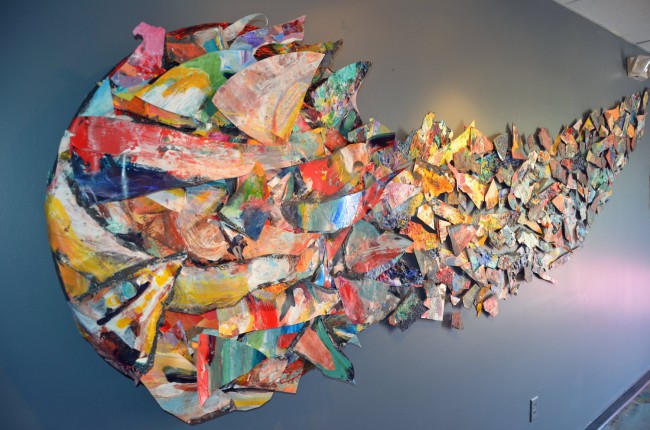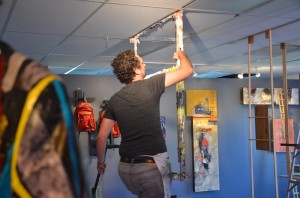
The original marathon legend dates back to 490 BC when the Greek messenger Pheidippides ran from the battlefield of Marathon to Athens to announce victory against the Persians to the Athenian assembly, only to collapse and die.
The story behind JJ Graham’s “Marathon,” the title of his newest show at his own Hollingsworth Gallery—opening with a free reception this evening at 6—is less of a legend and, so far at least, less lethal to its creator, who nevertheless has something of Pheidippides’s frenzy to him: the show is a victory of sorts, if only because Graham managed to pull it off in 10 days flat, all with new work (with three paintings’ exceptions), many with new concepts, some literally off the walls and off the ceilings, some snarkily self-referential, and some in a viciously account-settling mode, the way only artists—who are second only to Sicilian mobsters in that regard—can settle accounts.
Graham wanted to do something radically different, in good part because Hollingsworth Gallery shows were becoming stale. Shanna Fortier, the Palm Coast Observer photographer and reporter, had even told him what anyone who’d covered the gallery religiously hadn’t had the courage to tell him: that it was becoming more difficult to write about the shows because there was too much repetition. Works that had appeared in one show were reappearing in another, slightly altered or not altered at all, and the contemporary signature of the gallery was giving way to more conventional short-cuts.
That’s the idea behind one of his paintings that he “veiled as something new” by coating the lower half of the portrait with a grayish hue, and passing off the result as new work: it’s one of the many inside jokes of the show, this one targeting artists who’ve repeatedly done the same thing, minus the irony. Enough, Graham is saying.
“I want to open the gates,” he said Friday afternoon, still in full working mode as he worked on an installation about nature mutating from environmental wreckage. The piece was itself mutating in front of a visitor’s eyes the more he worked on it. A thin wooden frame juts down from the dropped ceiling in the middle of the gallery floor, dripping with paint and ideas conveying nature’s destruction wrought by environmental cataclysms. Graham was inspired to do the piece by a conversation with a Ukrainian who described the otherworldly aftermath of the Chernobyl nuclear disaster, when animals grew limbs in the wrong places, children grew up without limbs, and nature itself was knocked off its orbit. The wooden frame, which interrupts the gallery space without stopping it and creates the illusion of a painting that isn’t there, forces you to look at the resulting mess on its edges.
“That’s why I went conceptual with this show,” Graham, continues, “because you know what, I don’t want anyone ever coming to me and saying we’re seeing the same stuff.” With work like this he wants to “give artists permission” to think away from the conventional, and to dare them to come into his gallery and take on his walls and ceilings, take on the spaces—take on Graham’s own work, for that matter—and make their own new work out of it. That’s going to be the intention a few weeks from now, when Graham looks to his next show: he wants other artists’ works to bleed into his own. He wants artists to claim a portion of wall and go to work, and be willing to be judged by Graham, who will decide whether the new work gets to knock off one of his own or not.
That, too, is a different concept of using his gallery—as a sort of poetry slam, but with visual art, and with Graham’s work setting the standard. It’s gutsy. It’s original. It’s presumptuous as hell. But no more presumptuous than the creator behind the six days of Genesis, who then turned over his gallery to Adam and Eve. “I’ve got to make it interesting,” Graham says. “I was getting bored.”
The show grabs you from the get-go with “Looking Beyond,” a gigantic comet beautifully rendered from shards of former paintings and assembled in colors as vibrant as the piece’s movement even though it’s nailed across the length of the right wall as you walk in. The ride from there on can be bumpy as it collides with the dark matter of Graham’s furious mind.

That gave Graham 10 days to have a show ready to open for a public reception tonight. “Ten days straight of solid freaking work,” as he put it. The marathon was on.
The result is alternately inspiring, familiar, surprising, hurried, funny, rarely shocking, occasionally didactic or narcissistic, and always interesting, but, like Jack Kerouac’s verbally projected heaves, not necessarily always artistic: Graham, an intuitive artist by nature, made a conscious decision to let his intellect roam free this time, so free that in places it takes over, smothering his sensibilities with a hectoring finger. Several works combine the dark, angry humor of the late Richard Schreiner, who had been Graham’s closest friend and artistic soul mate—and an integral part of Hollingsworth Gallery—before his untimely death last year, and Jenny Holzer, the conceptual American artist who’s made an art of projecting polemics on everyday objects and public spaces.
There are no restraints, no second thoughts. It’s as often Graham the commenter as Graham the artist.
Some of the works are collaborations with other artists, as with a painting he did with Weldon Ryan or a “Lawsuit” jacket designed by Petra Iston, his girlfriend. Graham archetypes are all there: the ladders, the half-skyward gazes, the wandering souls. But mutations are all over the place, too: flying contraptions that are half helicopter half plane, trucks that are half fire truck half ice cream truck (fire and ice, you see), backpacks turned into dangerous, evil objects (as they very much are when left unattended in public places), buckets that the artist warns you about looking into. There are three of those, sitting on what looks like fixed swings dropping from the ceiling, with a warning sign that states: “staring into these buckets may cause these side effects:
–Mild Rash
–Loss of Sense of Taste (and other senses)
–Amnesia
–Nausea
–Enlarged breasts (in men, sorry ladies)
–Dizziness
–Hallucinations
–Euphoria”
And so on for 10 more symptoms. You look into each bucket. It’s an image of Graham staring back at you in primary colors and with a smile as sincere as it appears devious. The work is titled “Self Deprecation.” The symptoms might as well be a brief history of the artist.
Much of the work cannot be described—not because it’s beyond description, but because it would ruin the surprise, the effect of that first look, as with the rather delicious painting of a legendarily busty character of American lore. Half the joke is in the painting’s location. But there may not be much more than the surprise. There’s also the conceptual works featuring two poetry books by James Harter Sr., literally either shredded or nailed shut, in one of those pay-back moments Graham is allowing himself as a retort to something the poet said of art, according to Graham: “I only buy art to match my furniture.” Graham turned the phrase around and chalked it on one of the two book’s coffin-like contraption, under the heading: “Content Is Irrelevant.” The phrase reads: “I only buy books to match my furniture.”
“I’m probably going to get some blowback from that piece,” Graham acknowledges, “but you know, what the hell.”
Those works are part of a wall that Graham appears to have turned over to his demons, a place to exorcise his frustrations. It includes a visual haiku called “The Last Straw” and the most expensive work in the exhibit, ostensibly selling for $14,000, called “Stinger.” It’s a send-up of the almighty dollar, with a valid lottery ticket as the punch-line.
The symbol of the show is Graham’s very own footprint, what may become a new archetype. “This,” he says, “is my artistic footprint.” And there’s no doubt who is running that marathon.
![]()
JJ Graham’s “Marathon,” Graham’s first one-man show in two and a half years, opens with a free reception on Saturday, May 11, at 6 p.m., at the Hollingsworth Gallery, at City Marketplace. Reach the Gallery at 386/871-9146 or visit its website.





























Perry Mitrano says
we will be there tonight JJ good luck!!!!
Eden Cross says
LOVED the show!! Great, humorous and of-the-moment works of art mixed in with JJ’s more serious side! Can I wear that jacket, please!! JJ always has something surprising going on and this is a pleasurable and thought provoking show…
Deborah Susswein says
J.J. has reinvented himself and his gallery. It’s the most enjoyable, satisfying, joyous/humorous, crazyfun, creative, inspiring opening I’ve been to at Hollingsworth. A breath of fresh, lively lustful, delicious sweet air. Just GO!
Maxine Kronick says
SENSATIONAL SHOW!!! IN A WORLD FULL OF COPIES, YOU, JJ, ARE TRULY AN ORIGINAL.
Thank you for your amazing contribution to our arts community.
Arlene Volpe says
Great comentary on a fresh, fantastic show.
Perry Mitrano says
Great showing JJ at his best!
peter cerreta says
JJ had the guts to revisit the past to jolt the widespread acceptance of the “same old, same old” in art. This show, Neodada ( my term) puts mega vitamins on the artist’s blueplate special. Artists, if they want to stay vital should take note of JJ’s message in this show (as I see it) i.e., risktaking in art no matter if a giant splash or a little ripple is prime, not crazy! Love you, JJ!
w>ryan says
Fresh!!!
Christine Sullivan says
JJ’s Marathon show at Hollingsworth Gallery is a home run. It is alive and breathing while also breath taking. It’s energy and messages push the boundaries and make you stop, dive into and interact with each of the works – actually making you THINK (?!?) while pushing and pulling a reaction from the soul which, for me, was a mixture of laughter and tears. A true reflection of how things are in the world today while inspiring, no giving us a much needed kick in the butt! This show puts Palm Coast and JJ Graham on the art world map. A must see. Congratulations!